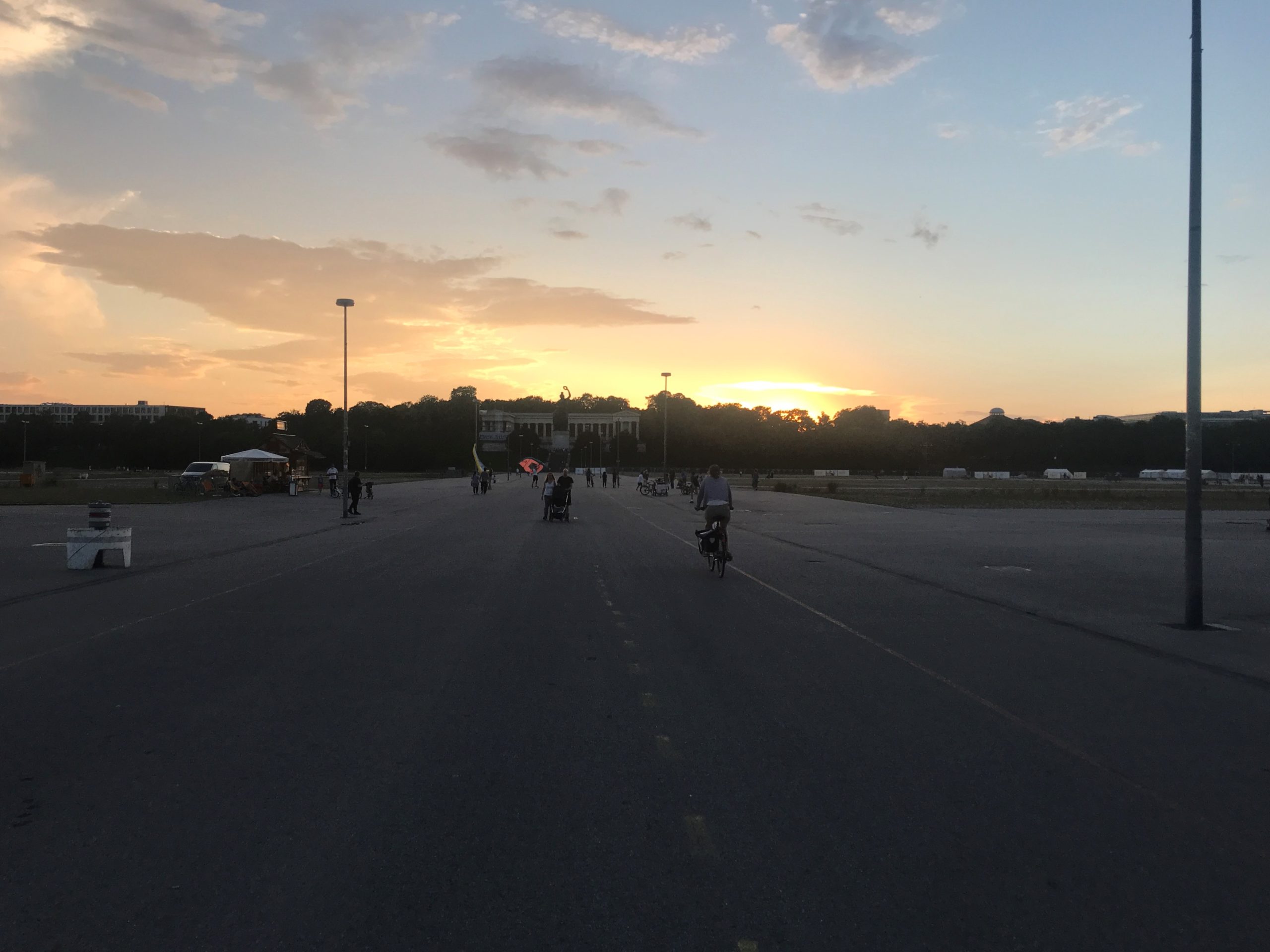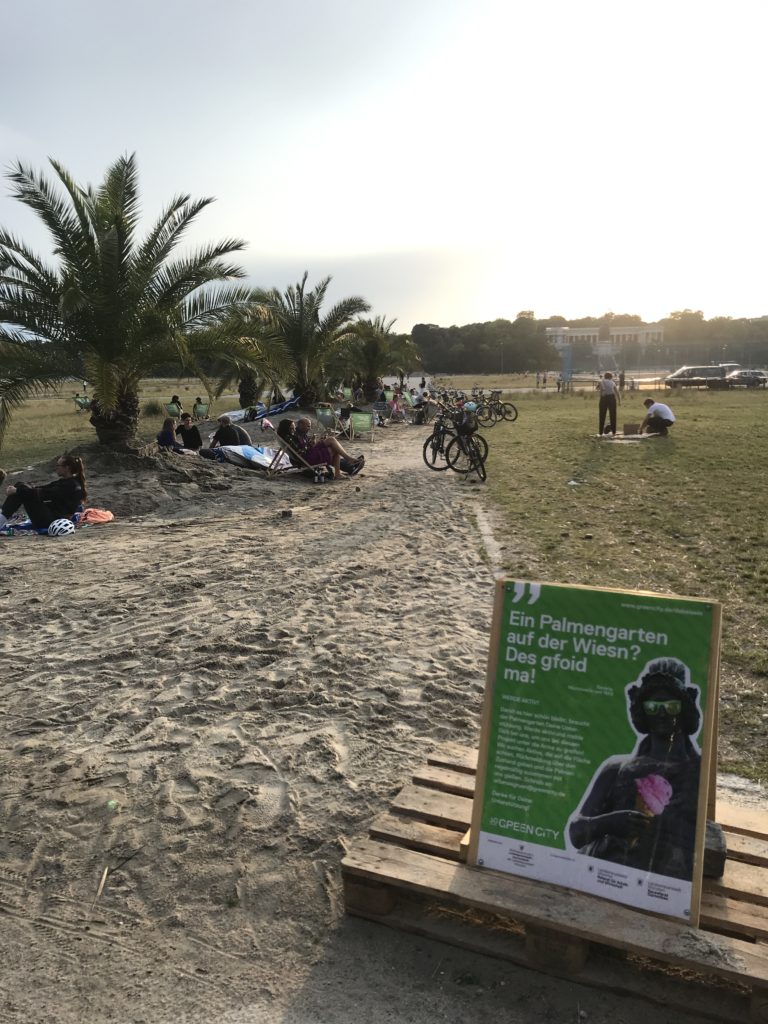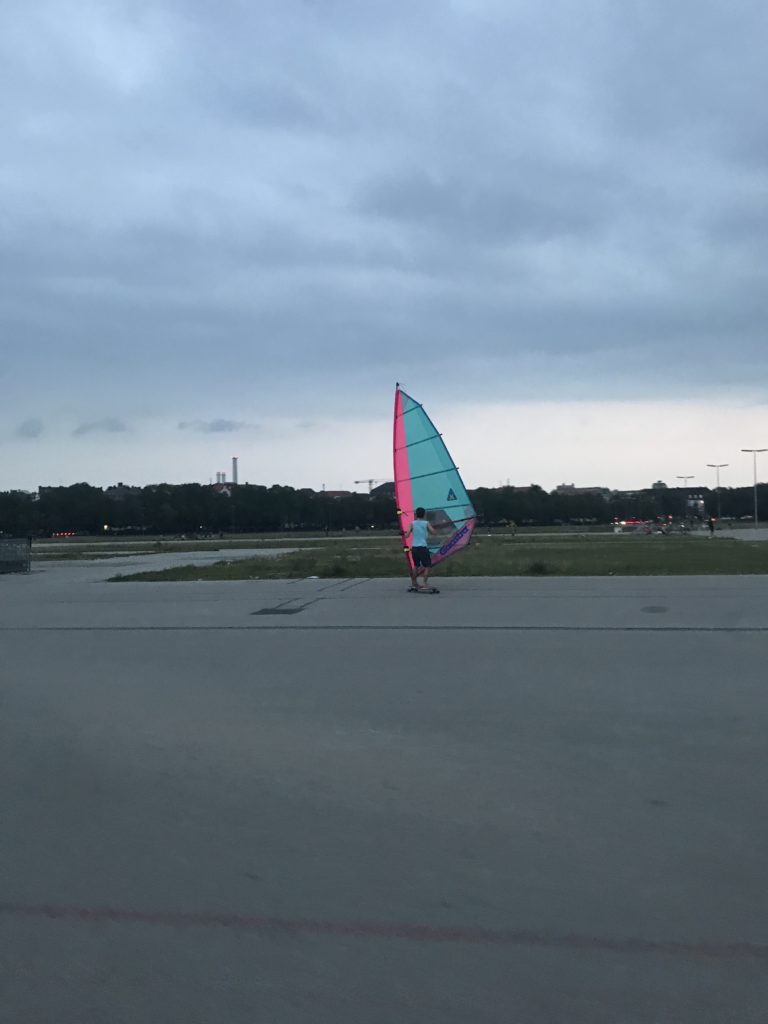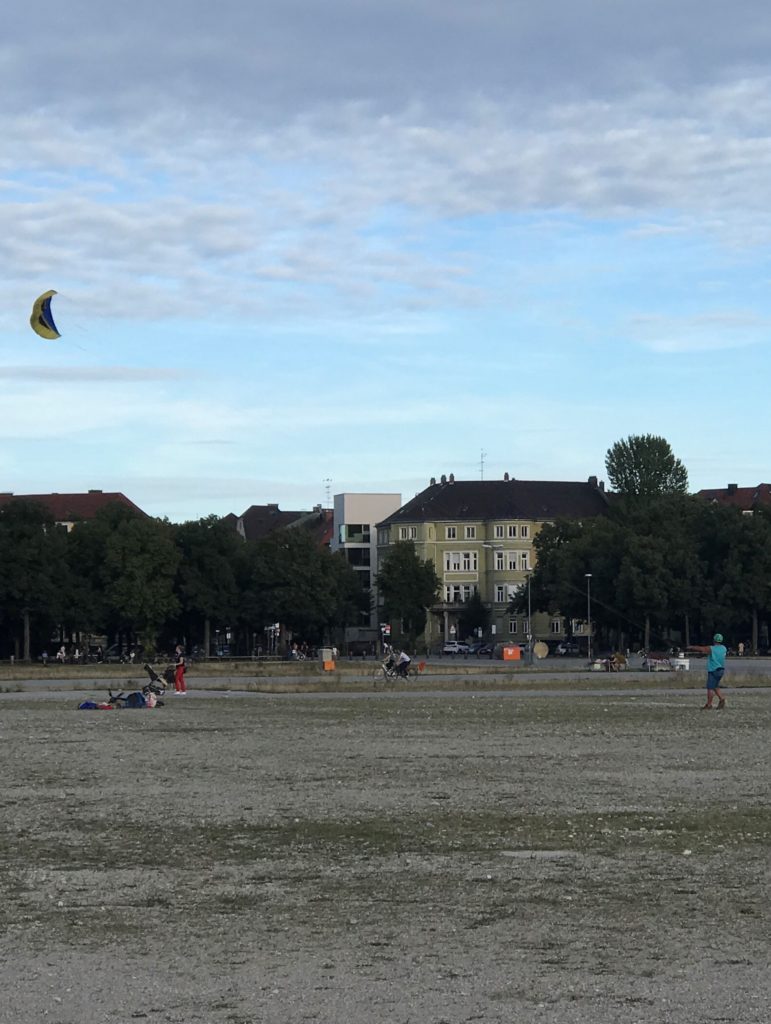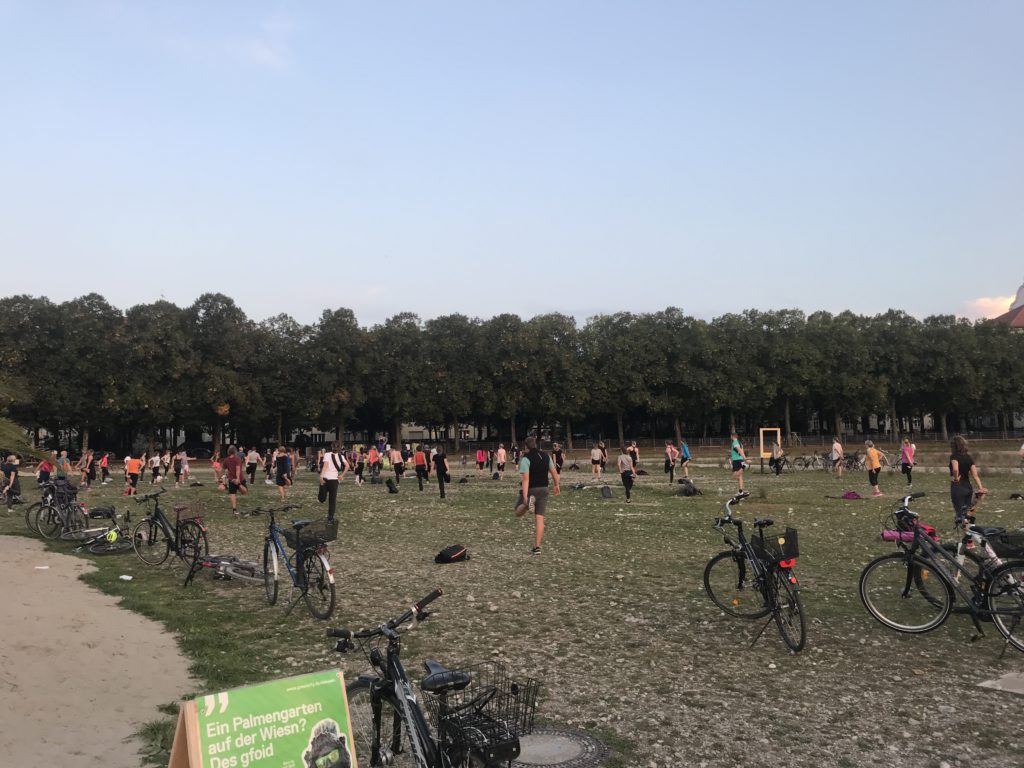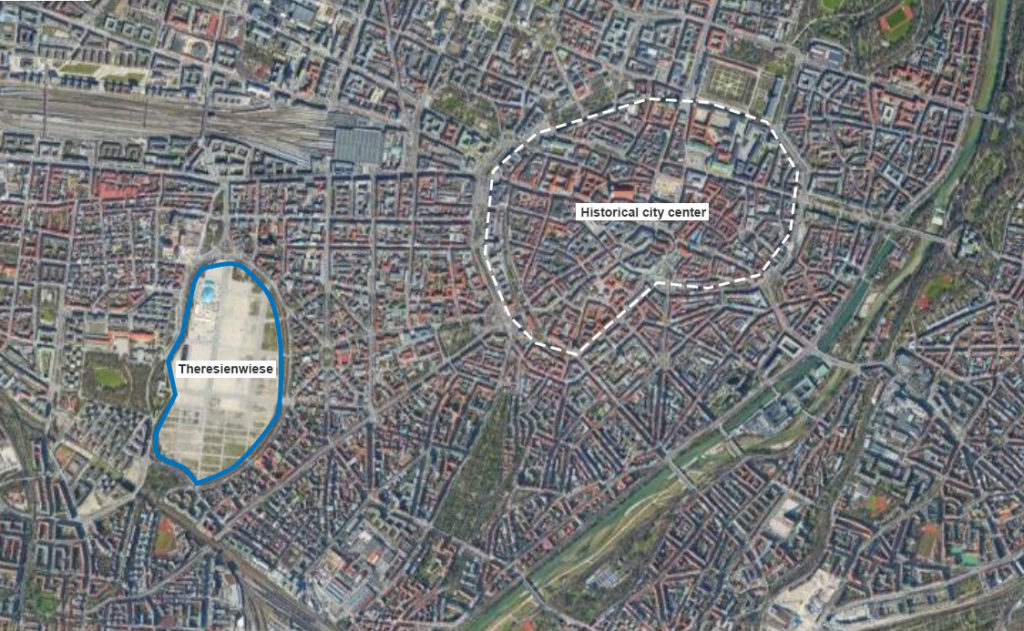
The land of a 210 year old tradition
Someone who has been through the struggle of finding a flat to rent in Munich might have also asked himself : “Why does a gigantic void such as Theresienwiese still exists??” This is a plaza of 42 ha, which is equivalent to 58 football pitches, located near the center of Munich. If we apply the density of the adjacent neighbourhood Schwanthalerhöhe, this could contain homes for approximately 6 000 inhabitants. This area locally called the “Wiese” (the field) is best know for its yearly event for which Munich is renowned: The Oktoberfest.
This event leads each year to the installation of tents and rides more than a month before the opening date, to 6,3 Million visitors coming dressed in colourful traditional outfits ready to drink 7,3 Million Litres of beer (in 2019), and to a total profit of 1,2 billion Euros (in 2018) (Source). All of this over just 16 days! This is definitely a cultural and economic asset for the city despite its short time frame. This event is of course the main reason for the existence of such a field in the city since the first Oktoberfest event in 1810! Nonetheless, other temporary events take place here such as Frühlingsfest (a smaller equivalent of Oktoberfest in spring), and other markets and flea markets.
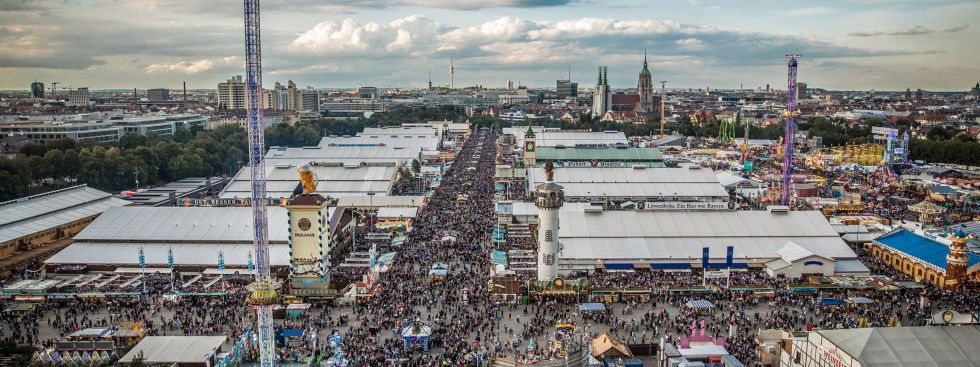
What happens when there is no Oktoberfest?
Of course this year is different. Because of the on-going health crisis , there will be no Oktoberfest. This is a regrettable cancellation, but a necessary one and allows us to reflect on the existence of such a space. We all hope such cultural events will be able to resume soon but, in the meantime, the emptiness of such a space allows us to see what other activities can take place there and all the opportunities presented by this land.
At the announcement of the cancellation of the event in May, this is exactly the question inhabitants and the city council started asking themselves. Some suggested installing a drive-in cinema, but the idea was rapidly put aside and, instead, it was decided to make the land greener, more insect-friendly, offering more shaded areas and to use it as an opportunity for cultural and artistic projects. (Article here)
This is what was actually organised during the summer. A stage hosted some concerts by local artists, a “beach” with sand and palm-trees was organized by Greencity, an environmental association, some little food-trucks and other small scale initiatives were also distributed on the land. Also to notice, Theresienwiese hosts a drive-in Covid 19 testing station which gave it an essential role in this pandemic time. All those initiatives have fostered some activity, but on such a vast ground most of it remained unoccupied. Nonetheless, every evening, this was my favourite place to ride through and observe people. So what made it so interesting?
People’s creative uses
Simply the spontaneous activities of evening strollers and their surprising ideas! I am astonished every time and here comes a (long) list of those as I really find it fascinating: wind-skateboarding, kite-flying, drone-flying, model airplane-flying, learning to Rollerblade, learning to ride a bike, learning to dance, learning a choreography by a dancing crew, fitness classes, baseball games, uni-hockey, football, practicing Parkour on metal frames, practicing Fencing, installing a table and drink with friends, playing music with a band, demonstrating, filming a TV-report, interpreting a theatre play … I am sure that there are also many others.
It is simply an interesting space by the variety of things you can find there! It is actually one of the favourite strolling place of locals and one of them confirmed to me that during the pandemic-induced lockdown, this was a great place of sociability! At a time where we all had to stay alone, this was the place people went to simply see life going on, to feel linked to a community. As humans we adore observing people, I believe it makes us feel safe and alive. We are social animals and even seeing others from a distance, makes us happier. We entertain each other. Moreover, all this variety of activities just makes the place so interesting and one never knows what one will see next time! This is exactly where the success of this void lies, its emptiness fosters possibilities.
A space which looks like no other
This emptiness is the strongest asset of this space. It’s geometry/shape/position is also what participates in making this spot so noticeable. As one arrives upon the Wiesn, he is struck by the vastness and the depth of view. As the land is surrounded by trees, the view of the surrounding buildings is obstructed.This accentuates the feeling of being cut off from the city and creates a uniform background making the eye notice even more the wanderers. There is nothing standing in the way, nothing obstructing the view. The only thing to look at is the ground, the sky and the people.
Firstly the ground includes wide asphalt alleys which are used as streets during the festivals. It also allows trucks to drive in to install the tents and rides. Between those alleys the ground is bare with just a little grass and a few rocks. This simplicity of the ground allows a flexibility of uses that cannot be found in parks for example.
Secondly, It is rare to see such a large part of the sky in a city as, usually, the streets narrow down the “Sky view factor” to a low value. This unusual openness makes me notice every evening the beauty of the sky with all its variations. This also means that this terrain enjoys the last rays of sun longer as no buildings create shade. An other particularity is the recurrent wind which pics up there because of the lack of protections. This geometry creates a specific micro-climate thus inducing special uses. Indeed, people come here particularly to enjoy the late summer sun or to fly kites. This underlines the importance of micro-climates in cities as it is what distinguishes a successful space from an other.
The Example of Tempelhof, Berlin
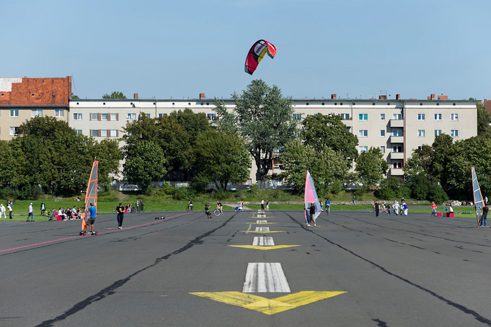
This is a question which has already challenged an empty terrain right in the middle of a large city: Tempelhof in Berlin. This former airport was one of the most important of Germany. It used to be the headquarters of the Lufthansa airline and enabled the supply of the western part of Berlin with the airlift between June 1948 and September 1949, when the area had all its other supply routes cut off by the soviet authorities. This strategic role made it globally famous. Its activity then continued as a normal and military airport and total activity finally stopped in 2008. In 2010, the airfield was opened to the public as a park. The different terminal buildings have since been used for multiple shows, exhibitions, concerts and host on a daily basis companies and start-ups.
The 300 ha open space was described by Ingo Gräning of Tempelhof Projekt, the state company running the site,as a “crown jewel” that no other city could treat itself with . During local elections in 2011 a housing project was presented which would cover only 25% of the park, create 4700 homes and a public library. (Source) Even if the developers promised to build social housing, this project had trouble being accepted as inhabitants worried it would just be a profit-driven real estate investment. A referendum was held to decide on the future of the airfield and 64.3% of the voters decided to keep the field exactly as it is. This decision was describes as an emotional one from the inhabitants who saw it as a way to say no to capitalistic approaches and who accepted no compromises on the project.
This drastic decision can indeed be questioned as scarcity of housing in big cities is a real problem. Open empty space is valuable, but where is the right balance? I believe one point Tempelhof underlines, is that spaces have a unity. Tempelhof has boundaries and it is unsure that it would survive if part of the surface was transformed. The Theresienwiese has similar issues. The circular form and the tree limit strongly participate in its identity. No matter how big, spaces are meaningful and even while serving a “real use” only part of the time, the free space is full of possibilities. Not considering space only in an utilitarian way allows unexpected and creative uses to take place.
“The void is not the vacant space, on the contrary, it is filled with everything that exists, changes, moves, interferes. The void is […] perpetually changing“
– Serge Renaudie, La ville par le vide
Refferences
Articles
- Theresesienwiese during the summer of 2020: https://www.sueddeutsche.de/muenchen/muenchen-theresienwiese-autokino-kritik-1.4890136 ; https://www.sueddeutsche.de/muenchen/muenchen-theresienwiese-plaene-bezirksausschuss-1.4898230
- On Tempelhof: https://www.theguardian.com/cities/2015/mar/05/how-berliners-refused-to-give-tempelhof-airport-over-to-developers ; https://www.goethe.de/en/kul/arc/20638590.html
Book
- Serge Renaudie, La ville par le vide, Online book here
